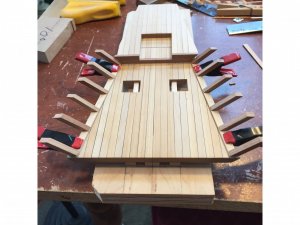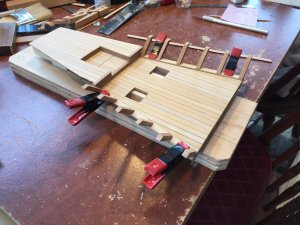-

Win a Free Custom Engraved Brass Coin!!!
As a way to introduce our brass coins to the community, we will raffle off a free coin during the month of August. Follow link ABOVE for instructions for entering.
You are using an out of date browser. It may not display this or other websites correctly.
You should upgrade or use an alternative browser.
You should upgrade or use an alternative browser.
Thanks, guys!
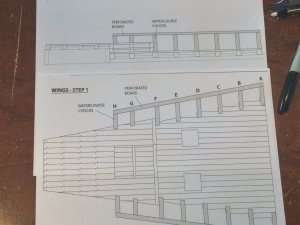
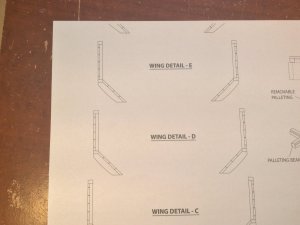
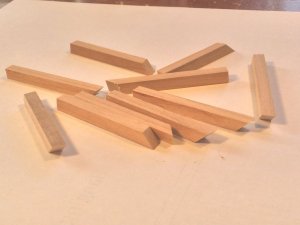
The "wings" form the side walls to the powder room and the filling room. They are constructed by fabricating stanchions known as "watercourse chocks" which are then planked over. They arise from the deck at a 45 degree angle and angled 10 degrees from the centerline of the ship. These wings will be the toughest part of this build by far. They are topped with the perforated board, and from there the sidewalls go straight up. The first picture shows a plan view and longitudinal view of the chocks. The second photo is cross sections of the wing at a few levels. The last photo is some blanks, cut at 45 degrees and 10 degrees to form the compound angle. Next up it to build a jig so I can uniformly cut the top of the watercourse chocks correctly.



The "wings" form the side walls to the powder room and the filling room. They are constructed by fabricating stanchions known as "watercourse chocks" which are then planked over. They arise from the deck at a 45 degree angle and angled 10 degrees from the centerline of the ship. These wings will be the toughest part of this build by far. They are topped with the perforated board, and from there the sidewalls go straight up. The first picture shows a plan view and longitudinal view of the chocks. The second photo is cross sections of the wing at a few levels. The last photo is some blanks, cut at 45 degrees and 10 degrees to form the compound angle. Next up it to build a jig so I can uniformly cut the top of the watercourse chocks correctly.
Glad to see you doing this quite some time ago there was an auction at the MSB site where Dave Stevens from the Lumberyard donated 4 kits to the site I got one of them and started the model(the kit is what I like to call a semi-scratch build with some items lasser cut and most of the balance you he to scratch build, I got the watercross chocks done OK, my problem was the perforated board construction, did it 3 times just flat out bad both interior and back I still have the model unfinished, I will post a picture of where I am at, as you are doing this and I admire your work greatly,I take it apart for the 4th TIME and follow your progress to see how you do the perforated board, one of my problems was the stain I used a Min-Wax penetrating stain that did not penertrarate, I now use Min-Wax Gel Stain works much better, the only problem I have with it is for some reason I can not do it with a brush as is sometimes neccessary I use a rag to apply it the results is in my Gunboat Philadelphia build, looking foreward to both your builds( the Blanford and this one, maybe I can get better as I do more builds. Don
Thanks, guys!
I drew lines on the deck depicting the inboard location of the watercourse chocks. As you can see from photo #1, in the aft most position there is little deck surface for the chocks to grab when glued in place (see arrows). I decided to add a "toe board" of box wood to make assembly and gluing easier. Photo #2 shows the wing assembly under construction.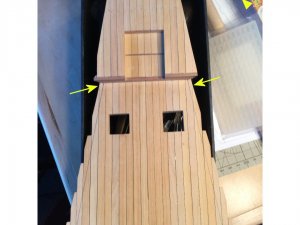
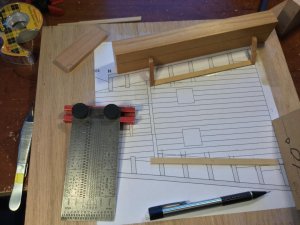
I drew lines on the deck depicting the inboard location of the watercourse chocks. As you can see from photo #1, in the aft most position there is little deck surface for the chocks to grab when glued in place (see arrows). I decided to add a "toe board" of box wood to make assembly and gluing easier. Photo #2 shows the wing assembly under construction.


Dave you proball gave me a solution to my problem, will waite to see how you develope this and then I will oull it apart for the fourth time and try to do it again. Don
Glad if I can help, Don. I thought a long time about how to do this. The biggest problem is that the perforated board is straight and level, but crosses 2 different deck heights, with different watercourse chock heights for each. On my model the difference in height is 7/16". I'll post more soon.
Thanks, Knut!
Very clean and accurate work - would like to see more often some updates, in order to see the fine details in your woodwork
Canoe21
Lawrence
Hello Dave
Just found your build log on the Aft. Magazine. You are sure doing a great job on it, that's for sure. So very much detail involved, and at the larger scale that you are working with sure makes it much easier to lay it all out. This sure is a very interesting build, even more so for me as I just finished building my magazine for the Oliver Cromwell, ENJOY.
Regards Lawrence
Just found your build log on the Aft. Magazine. You are sure doing a great job on it, that's for sure. So very much detail involved, and at the larger scale that you are working with sure makes it much easier to lay it all out. This sure is a very interesting build, even more so for me as I just finished building my magazine for the Oliver Cromwell, ENJOY.
Regards Lawrence
Moving along very well Dave. I've only seen a few of these built since we made the plans available. There are many potential projects like this that I think could be built and would be quite fun to do as well.
Thanks, Guys!
Winston: I agree. Jeff Staudt was prolific, and turned out some nice plans. I've built the Battle Station and his 17th century cannon, and started the Batteau (that's a secret!) Too bad he's not active.
Winston: I agree. Jeff Staudt was prolific, and turned out some nice plans. I've built the Battle Station and his 17th century cannon, and started the Batteau (that's a secret!) Too bad he's not active.
I to have built the Batteau, one of my first, came out quite well. Don
Thanks Ted! This build is stalled at the most difficult stage: installing the stanchions on the filling room deck followed by the perforated boards. After that, smooth sailing. I plan to get back to this soon!
Canoe21
Lawrence
Hello Dave, Just stopping by to look for another of your great updates but alas it looks like I am just a bit early.
Regards Lawrence
Regards Lawrence
Kurt Konrath
Kurt Konrath
What was purpose of the second raised deck in filling room?The filling room deck is supported by 3 beams, each 3/16" square. The planking is set into rabbets cut into the beams.
View attachment 70140View attachment 70141View attachment 70142View attachment 70143
This is very interesting, I knew powder was kept low in hold, but not how it got processed and moved up to fighting decks. I have heard of the term "Powder Monkeys" for the young lads who carried powder up during battle.





